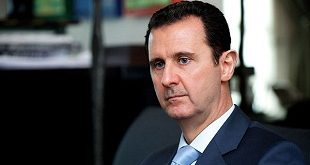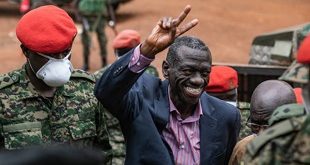
By Haggai Matsiko & Flavia Nassaka
Alarm over terror alerts, attacks on police, army installations
July 3, 2014: The U.S Embassy issues terror alert: The U.S Embassy has received information from the Uganda Police Force (UPF) that according to intelligence sources there is a specific threat to attack Entebbe International Airport by an unknown terrorist group today, July 3rd, between the hours of 2100-2300. Individuals planning travel through the airport this evening may want to review their plans in light of this information.

July 3, 2014: The Uganda Police and army deploy heavily armed troops in the capital city, Kampala: Columns of foot patrols and motorised guns and snipers—with menacing looking guns and camouflage outfits roamed city streets as the dismayed public watched in fear and awe.
Deputy police spokesperson Polly Namaye told journalists: “We received intelligence reports, which they passed on to the US Embassy, that an unknown terrorist group would attack the airport between 9pm and midnight. We couldn’t take anything for granted. We deployed both JATT and the Counter-Terrorism Police to carry out more searches.”
July 3, 2014: The Uganda Police backtracks: The Uganda Police did not give any such specific information to the United States embassy about planned terror attacks on Entebbe International Airport… we wish to reassure the public, especially the travelling public who use Entebbe International Airport that there is no cause for alarm. There are adequate and effective counter terrorism measures in place to deal with any threat to the Airport or any other place in Uganda. In fact, as we alerted the public before, because of the on-going World Cup season, we have taken extra measures to ensure that the country is safe and secure.
By evening of July 3, all top government spokespeople, the police, and army were scurrying to distance themselves from the U.S Embassy terror alert.
The government spokesperson, Ofwono Opondo, called it “alarmist”. The Inspector General of Police, Gen. Kale Kayihura and the Force’s spokesperson, Assistant Commissioner of Police Fred Enanga, denied sharing intelligence with U.S. Ambassador Scott DeLisi’s team.
This comes at a time when the Uganda police, and specifically Gen. Kayihura, have for some time had a sanctimonious relationship with the U.S. mission in Kampala. The U.S. government recently announced it was cutting US$2.4 million in aid to police. This followed a heated verbal exchange between Gen. Kayihura and U.S. Ambassador DeLisi over the police raid on the U.S. –sponsored Makerere University Water Reed Project (MUWRP).
July 4, 2014: Police announces it has arrested and detained two suspected terrorists at the high-end shopping centre, the Forest Mall, in eastern central Kampala city. It turns out to be a false alarm. The suspects appear to have no links to terrorists and are released.
The scare-mongering and bungling of the security forces, especially the police, is becoming unbearable. It is clear something sinister is happening but either the security forces are jumpy and cannot put a finger on it, or they know more than they are letting on. Talk show pundits publicly criticise the false alarms.
“The public might not take the police too seriously the next time it issues a terror alert, and that could be dangerous,” someone warns.
July 5, 2014: Miles away from the city, unidentified attackers armed with spears, machetes, and guns simultaneous strike 13 government installation in three districts in the western districts of Bundibugyo, Kasese, and Ntoroko. Up to 90 people; mainly civilians, five police and five soldiers, are killed. Shockwaves sweep across the country. The security and intelligence forces appear exposed and barely able to guarantee security.
The area struck is the heartland of the oil-rich Albertine Rift region that is believed to be heavily guarded by Uganda’s elite troops, the Special Forces Group of Brig. Muhoozi Kainerugaba, which also guards President Yoweri Museveni.
What is going on? Are the attacks coordinated or coincidental attacks? Could the attackers be tribal militias, members of the notorious Allied Democratic Forces (ADF) who are known to operate just across the border in the DR Congo, or are they an emerging rebel group?
Why did the security agencies fail to detect plans of alleged ragtag and amateurish groups of youths at the time the country is on high security alert? Can such a force detect and foil plans of more sophisticated terrorists?
President Museveni, in a statement on the attacks, also blames failure of intelligence.
He asks: “How did these people weave such a scheme without being pre-empted? What were the (Gombolola Internal Security Officer) GISOs doing?
Experts told The Independent that the lapse in intelligence shows that the security agencies are not in charge in an area that is conflict-heavy, and that remains perilously in earshot to DR Congo hideouts of rebel elements like ADF.
“Of course, these attacks are a serious concern,” says Bubulo East MP Simon Mulongo, a security expert who also sits on the Parliamentary Defence Committee, “Police is the first line of protection, therefore if police stations are being attacked it raises questions about how safe everybody else is.”
Mulongo says, coming at a time when Uganda is on alert over terror attacks, the short falls of intelligence worryingly points to a lack of proper coordination between the intelligence organs.
“This might be undermining intelligence gathering,” Mulongo says.
Intelligence crisis
Uganda has one of the largest numbers of security agencies and personnel in the region. The most known include the police, army, the Internal Security Organisation (ISO), the External Security Organisation (ESO), the Chieftaincy of Military Intelligence (CMI), the Police Rapid Response Unit (RRU), the Presidential Guard Brigade (PGB), and the police Criminal Investigations and Intelligence Directorate (CIID). Others are the Joint Anti-Terrorism Taskforce (JATT) and the police Counter-Terrorism Unit.
But there have been myriad small, almost sleeper groups like the Black Mamba, the Kalangala Action Plan, and the Kiboko Squads. It is not unusual, in cases requiring armed intervention, to see civilian-dressed individuals totting automatic rifles and pistols. There result, invariably, is confusion, gaffes, and failure.
As the police responded to the latest attacks in Bundibugyo on July 7, the top political boss in the area, the Resident District Commissioner (RDC), Pius Mujuzi, was shot in the leg by police who suspected him to be an attacker. He had a gun and, as a civil leader, was not in uniform. Together with IGP Kale Kayihura, Mujuzi had spent the previous day coordinating the security response to the attacks in the most populous district in Western Uganda.
In November last year, The Independent published a story titled `Intelligence in crisis’, where it was reported that intelligence bodies had failed to detect several breaches; including now exiled Gen. David Sejusa aka Tinyefuza’s clandestine gathering of counter-intelligence about the army. Relying on his network, Gen. Sejusa fled when he Gen. Kayihura was on the point of netting him.
Gen. Sejusa, who was a Senior Presidential Advisor on Security, and the Coordinator of Intelligence Services, appears to have become disgruntled that Gen. Kayihura was usurping his role.
President Museveni and his defacto points-man person on security matters, his son, Brig. Kainerugaba appeared to apparently regard Gen. Kayihura more highly than Gen. Sejusa.
Before he fled into exile, Gen. Sejusa complained of being shunted aside and publicly criticised Gen. Kayihura over “uncoordinated, and in some instances, reckless utterances”.
Since Gen. Sejusa left, the position of Coordinator of Intelligence Services has never been filled. Instead, on top of heading the expanded police force, Gen. Kayihura appears to be filling the function. Even other previously powerful bodies, like CMI, ISO, ESO, and JATT, are pale shadows of their glorious past. It appears when Gen. Kayihura hogged President Museveni’s attention, the bosses of the other security and intelligence organs went to sleep. Gen. Kayihura is blamed for expanding his role at the expense of the operating budgets and roles of other intelligence organs.
In the latest security operation in the city and western Uganda, the Minister of Internal Affairs, Gen. Aronda Nyakairima, of Defence, Crispus Kiyonga, and of Security, Muruli Mukasa appear to have been over-shadowed by Gen. Kayihura.
ISO boss Brig. Ronnie Balya and ESO Director, Robert Masolo, continue to lie low. Only Gen. Kayihura and Brig. Muhoozi Kainerugaba have been seen in the Rwenzori region.
Coordinated attacks?
Observers claim the proliferation of intelligence organisations, without a streamlined chain of command, has led to inter-agency competition. As each agency has sought to either pull in its direction or undermine the other, the quality of intelligence gathering has become victim. Sometimes the disagreements are about approach.
Former ESO director, David Pulkol, has criticised the failures of intelligence actors.
“When I see the current arrangement dictated by naked force,” he told The Independent, “too many policemen in public places with weapons of all kinds, I get worried because the enemy we are dealing with cannot be scared by this kind of display of force. Otherwise, you run a risk of exhibiting your weaknesses, your lack of intelligence.”
Pulkol added: “terrorists, by their very nature like to lurk in the dark, take their time studying their victim and pounce on them when they least expect them”.
When on March 4, 2012, armed people attacked Uganda’s most critical military installation; the Mbuya Army Barracks on the south-eastern edge of the capital, the army dismissed it as the handiwork of disgruntled intelligence operatives.
But a wave of attacks targeting security operatives and military installations that has followed the incident have raised concerns the country’s security.
In June alone this year, several attacks have happened on military and police installations. Snatching arms appears to be part of the plans of the attackers. An official statement by the police says up to 20 guns were snatched by attackers in the July 5 attacks alone.
Before that, on June 26, unknown gunmen attacked and burnt a church in Kyegegwa district, and killed and brutally injured overnight worshippers. They killed an Assistant Inspector of Police, Grace Mwine, and burnt the church.
On June.18, armed men attacked the residences of Mubende police commanders including the District commander, Enock Abaine and Officer-in-Charge of Operations, Dan Ampadde. The attackers continued to the Mubende barracks in an attempt to raid the armoury but were dispersed.
On June.1, a one Bright Mukama, believed to be a former detainee at Luzira prison attacked Nsambya police station and killed a police officer, Cyprian Mukama.
The previous month, on May.14, another Police officer Hajji Abdu Ssebagala, was shot dead on his way home in Rubaga division. He was attached to the police flying squad of Namirembe police post in Kampala.
“The consequence of such attacks, however small,” Mulongo says, “is that they expose our nakedness. And the other problem of course is that people lose confidence in the government.”
However, while the attacks point to a trend of insecurity, Mulongo says that they do not exhibit a single thread in terms of organisation and chain of command.
“When you look at these attacks,” he said, “you do not see an organised and coordinated and professional hand, these are isolated underdog missions largely of a criminal nature.”
Mulongo says that the attacks in Rwenzururu are different—they were coordinated.
“But even these, in terms of military strategy,” he said, “they were amateurish. It is fool hardy to spread your numbers across three districts and not preserve your force. As you saw over 50 of them were killed in Budibugyo alone”.
Museveni blamed
The Rwenzori region army spokesperson, Lt. Ninsiima Rwemijuma says one group of the assailants reportedly attacked Bundibugyo and Kicho police posts and another group attacked two security officers, who were guarding a weigh bridge in Kasese.
The Army Spokesperson, Lt Col. Ankunda, has ruled out links to ADF despite the coordination in attacks and reports that the attackers had been trained for the mission.
The government insists that the skirmishes were tribal clashes between the Bakonzo and other tribes like the Basongora in Kasese, Banyabindi and Bamba in Bundibugyo. Some observers, however, have linked the attacks to a more organised body.
In his statement, the Rwenzururu kingdom Premier, Nzaghale Noah, cited two events as precursors to the attacks.
He said on June 20 “provocative announcement by Mr Byabashaija Augustine Amooti” was aired on various radios in the region calling upon the Banyabindi Community to come to Muhokya, Kasese to commemorate a 50th Anniversary of the massacre of the Banyabindi by Rwenzururu fighters.
The second, he said, could have been the July 2 attack on the Royal Palace of the Rwenzururu Kingdom on Kibanzanga Road Kasese Municipality.
“Bad elements could have used this misunderstanding as an opportunity for them to launch their atrocious attack because of the fertile ground that seemed to exist,” the Premier said in a statement.
Those who believe that the tribal attacks were fuelled by the tribal tensions claim that the attacks were to send out a message to the government that the Bakonzo were not happy with President Museveni’s recognition of a rival to the Rwenzururu chieftancy, the Obudhingiya Bwa Bamba—the Chieftaincy of Bwamba.
President Yoweri Museveni recently promoted and recognised Omudhingiya Martin Ayongi Kamya as the leader of the Bwamba Chieftaincy, which brings together the Bamba, Babwisi and Bavonama. Bakonzo saw this as an attempt to undermine their king.
This not the first time tension is heightening in the Rwenzururu region. In 2010, Bamba veterans threatened a war over their disagreements with Bakonzo and Basongora, who have been clashing over the Obusinga since 2007.
Apart from the tribal tensions, the region like many parts of Uganda teems with hundreds of army deserters and veterans. Early last year, in one operation, the army rounded up hundreds of deserters in the Rwenzori region. Almost all of them were later released. The same swoops appear to be happening after the recent attacks.
Scepticism about claims of tribal clashes remains especially because the attacks have occurred, undetected, in a conflict-heavy zone. They follow a spate of other attacks across the country that had nothing to do with tribal conflicts. Some say they point to a state of insecurity in the country.
Police spokesperson, ACP Fred Enanga says the police and the army are still carrying out investigations on who could be behind the Bundibugyo and Kasese clashes. He says after realising that most attackers target armouries for guns, the police and army units have beefed up security and are being retooled to improve their defences. As that goes on, however, President Museveni, Gen. Kayihura, and Brig. Kainerugaba need to ensure that intelligence organs do not sleep as the terrorists
 The Independent Uganda: You get the Truth we Pay the Price
The Independent Uganda: You get the Truth we Pay the Price


